Ernest Louis, Grand Duke of Hesse
Last updatedThis article includes a list of general references, but it lacks sufficient corresponding inline citations .(June 2020) |
| Ernest Louis | |||||
|---|---|---|---|---|---|
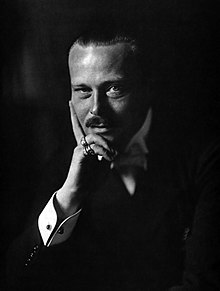 Photograph by Jacob Hilsdorf, 1905 | |||||
| Grand Duke of Hesse and by Rhine | |||||
| Reign | 13 March 1892 – 9 November 1918 | ||||
| Predecessor | Louis IV | ||||
| Successor | Monarchy abolished | ||||
| Born | 25 November 1868 New Palace, Darmstadt, Grand Duchy of Hesse | ||||
| Died | 9 October 1937 (aged 68) Schloss Wolfsgarten, Langen, Hesse, Nazi Germany | ||||
| Burial | Neues Mausoleum, Park Rosenhöhe, Darmstadt, Germany | ||||
| Spouses | |||||
| Issue | |||||
| |||||
| House | Hesse-Darmstadt | ||||
| Father | Louis IV, Grand Duke of Hesse and by Rhine | ||||
| Mother | Princess Alice of the United Kingdom | ||||
| Grand Ducal Family of Hesse and by Rhine |
|---|
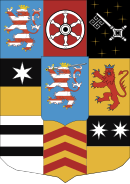 |
| Ernest Louis |
|
Ernest Louis (German: Ernst Ludwig Karl Albrecht Wilhelm; 25 November 1868 – 9 October 1937) was the last Grand Duke of Hesse and by Rhine, reigning from 1892 until 1918. [1]
Contents
Early life

Ernest Louis was the elder son of Louis IV, Grand Duke of Hesse and by Rhine and Princess Alice of the United Kingdom, daughter of Queen Victoria and Prince Albert of Saxe-Coburg and Gotha. He was named Louis after his father. His nickname was "Ernie". One of seven siblings, two of whom died in childhood, Ernest grew up with his four surviving sisters in Darmstadt. One of his younger sisters, Alexandra, would marry Tsar Nicholas II, the last Emperor of Russia, while another sister, Victoria Mountbatten, would be the mother of Queen Louise of Sweden, Louis Mountbatten and Princess Alice of Battenberg, who was the mother of Prince Philip, Duke of Edinburgh.
Ernest Louis grew up in a loving household, with parents who demonstrated their affection for their children, something not typical for that social stratum in those days. He grew much attached to his parents and siblings, and it was his misfortune that he was fated to witness several deaths among them during his childhood. When he was five, his only brother Prince Friedrich died. The two boys had been playing a game when the younger boy, who suffered from haemophilia, fell through a window onto the balcony twenty feet below. [2] Ernest Louis was inconsolable. "When I die, you must die too, and all the others. Why can't we all die together? I don't want to die alone, like Frittie," he told his nurse. [3] To his mother he said, "I dreamt that I was dead and was gone up to Heaven, and there I asked God to let me have Frittie again and he came to me and took my hand." [4]
In 1878, when Ernest was ten, an epidemic of diphtheria swept through Darmstadt. His father and all the children, except Elisabeth, who was visiting her paternal grandmother, fell ill. [5] Princess Alice cared for her sick husband and children, but on 16 November, the youngest of them, Princess Marie, died. Alice kept the news from her family for several weeks, until Ernest Louis, who was devoted to little Marie, asked for his sister. When his mother revealed Marie's death, Ernest Louis was overcome with grief. In comforting her grieving son, Alice kissed him. [6] She fell ill within a week, and died on 14 December, the anniversary of her own father's death. [7] [8]
Marriages
First marriage
On 19 April 1894, at Schloss Ehrenburg, Ernest Louis married his maternal first cousin, Princess Victoria Melita of Edinburgh nicknamed "Ducky", the daughter of his mother's brother, Prince Alfred. The match was actively encouraged by their mutual grandmother, Queen Victoria, who attended the wedding. At the wedding, Ernest's youngest surviving sister, Alix, became engaged to marry Tsarevich Nicholas of Russia, and the excitement of that imminent match threw the nuptial celebrations into the shade. [9]

Ernest and Victoria Melita had two children:
- a daughter, Elisabeth (11 March 1895 – 16 November 1903). Her early death at age 8 of typhoid fever greatly devastated her father who wrote "My little Elisabeth" in his memoirs "was the sunshine of my life" 30 years after her death. [10]
- stillborn son on 25 May 1900.
Ernest and Victoria entertained in style, frequently holding house parties for young friends (anybody above 30 was deemed "too old" by Victoria), dispensing with formality on those occasions to indulge in fun and frolic; Victoria's cousin Prince Nicholas of Greece and Denmark remembered one stay with them as having been "the jolliest, merriest house party to which I have ever been in my life." [11] These revelries were more in keeping with Victoria's inclinations than Ernest's. Their marriage was unhappy due to differences in temperament and attitude. Fond as she was of revelry, Victoria was less enthusiastic about fulfilling her public role. She avoided answering letters, put off visits to elderly relations whose company she did not enjoy, and talked to people who amused her at official functions while ignoring people of higher social or official standing whom she found boring. [12] Victoria's inattention to her duties provoked quarrels with Ernest. The young couple had loud arguments which sometimes turned physical. The volatile Victoria shouted, threw tea trays, smashed china against the wall, and tossed anything that was handy at Ernest during their arguments. [12]
Queen Victoria was saddened when she heard of the trouble in the marriage from Sir George Buchanan, her chargé d'affaires at Darmstadt, but because of their daughter, Elisabeth, she refused to consider permitting her grandchildren to divorce. Ernest also held off from divorce mainly for this reason. He adored his daughter to distraction and lavished his time and attention on her. The child reciprocated her father's affection, preferred the company of her father to that of her mother. [13] Meanwhile, all efforts to rekindle the marriage failed; Victoria took to spending most of the year in the south of France, spending vast sums in expenses and at the card-tables in Monte Carlo. When Queen Victoria died in January 1901, significant opposition to the end of the marriage was removed. [14] The couple were divorced 21 December 1901 on grounds of "invincible mutual antipathy" by a special verdict of the Supreme Court of Hesse. After the divorce had come through, Victoria told some close relatives that Ernest was a homosexual. [15] [16] Allegedly, she had caught her husband in bed with a male servant when, in 1897, she returned home from a visit to her sister Queen Marie of Romania. She did not make her accusation public, but told her sister that "no boy was safe, from the stable hands to the kitchen help. He slept quite openly with them all." [17] [18] Victoria later married another first cousin, this time on her mother's side, while Ernest married a woman from a mediatised family, Eleonore of Solms-Hohensolms-Lich.
Second marriage
Ernest Louis remarried in Darmstadt, on 2 February 1905, to Princess Eleonore of Solms-Hohensolms-Lich (17 September 1871 – 16 November 1937). [19] This marriage proved harmonious and happy. The couple had two sons:
- Georg Donatus, Hereditary Grand Duke of Hesse (1906–1937). He married Ernest's grand-niece, Princess Cecilie of Greece and Denmark, a sister of Prince Philip, Duke of Edinburgh, and had issue. The couple and two of their young sons were killed in a plane crash in 1937, leaving behind a daughter who also died two years later, while yet a child. [20] [21] [22] [23] [24]
- Louis, Prince of Hesse and by Rhine (1908–1968), who married Margaret Campbell Geddes, daughter of Auckland Geddes, 1st Baron Geddes; no issue. Louis adopted Moritz, Landgrave of Hesse as his heir, thereby uniting the two lines of the Hesse family.
In addition to his marriage, Ernest Louis maintained a close friendship with the bisexual Karl August Lingner, the inventor of Odol, one of the first liquid mouthwashes. [25] When Lingner died of tongue cancer, he bequeathed Tarasp Castle in Switzerland to Ernest Louis. However, the Hesse family never lived in it, and it was sold in 2016.
Grand Duke of Hesse
In 1892, Ernest Louis succeeded his father as grand duke.
Throughout his life, Ernest Louis was a patron of the arts, [26] founding the Darmstadt Artists' Colony, and was himself an author of poems, plays, essays, and piano compositions.
Ernest Louis commissioned the New Mausoleum in 1903. It was consecrated on 3 November 1910, in the presence of the Grand Duke and his immediate family, that is to say, his wife Eleonore, Tsar Nicholas II and his two sisters, the Tsarina Alexandra Feodorovna of Russia, Grand Duchess Elisabeth Feodorovna (Ella), Victoria, Princess Louis of Battenberg and her daughter, Louise, and Princess Heinrich of Prussia accompanied by her husband. The remains of Grand Duke Ludwig IV, Princess Alice, Grand Duchess of Hesse and by Rhine along with their children 'Frittie' and 'May' were re-interred in the New Mausoleum. [27]
First World War

During World War I, Ernest Louis served as a general of the infantry at Kaiser Wilhelm's headquarters. In February, 1917, the February Revolution in Russia forced his brother-in-law, Tsar Nicholas II, to abdicate. Sixteen months later, in July 1918, his two sisters in Russia, Elizabeth, the widow of Grand Duke Sergei Alexandrovich, and Alexandra, the wife of Nicholas II, were murdered by the Bolsheviks, Alexandra dying alongside her husband and children. At the end of the war, he lost his throne during the revolution of 1918, after refusing to abdicate. [28]
Death
In October 1937, Ernest Louis died after a long illness at Schloß Wolfsgarten, near Darmstadt. He received what amounted to a state funeral on 16 November 1937 and was buried next to his daughter, Elisabeth, in a new open air burial ground next to the New Mausoleum he had built in the Rosenhöhe park in Darmstadt. [29]
Legacy
His former sister-in-law, Marie of Romania, described Grand Duke Ernest in her memoirs:
Ernie could be the gayest of companions, he was in fact full of almost feverish life. There was something effervescent about him, rather restless even; he was highly strung and had the artistic temperament developed to the highest degree. He enjoyed everything and could also be a clever inventor of varied amusements.[...] Ernie enjoyed himself as much as we did and, his vitality being infectious, he did Nando a lot of good. In his youth my husband had not the faculty of real enjoyment; he was too anxious and this gave him a somewhat protesting attitude that we did our best to overrule. The truth was he was too much in awe of Uncle ; the fear of his “vetoes” was always with him, so he could never “let himself go” to complete enjoyment. Ernie, however, often helped him to overcome his inborn diffidence; the young brother-in-law, so to say, conquered Nando’s doubts with his much greater self-assurance.
Honours
He received the following orders and decorations: [31]
- German honours
 Hesse and by Rhine:
Hesse and by Rhine: - Grand Cross of the Ludwig Order
- Grand Cross of the Merit Order of Philip the Magnanimous
- Knight of the Golden Lion
- Founder of the Order of the Star of Brabant, 14 June 1914 [32]
-
 Anhalt: Grand Cross of the Order of Albert the Bear
Anhalt: Grand Cross of the Order of Albert the Bear  Baden: [33]
Baden: [33] - Knight of the House Order of Fidelity, 1888
- Knight of the Order of Berthold the First, 1888
 Bavaria : Knight of St. Hubert, 1892 [34]
Bavaria : Knight of St. Hubert, 1892 [34]  Brunswick: Grand Cross of the Order of Henry the Lion
Brunswick: Grand Cross of the Order of Henry the Lion -


 Ernestine duchies: Grand Cross of the Saxe-Ernestine House Order
Ernestine duchies: Grand Cross of the Saxe-Ernestine House Order  Mecklenburg: Grand Cross of the Wendish Crown, with Crown in Ore
Mecklenburg: Grand Cross of the Wendish Crown, with Crown in Ore Oldenburg: Grand Cross of the Order of Duke Peter Friedrich Ludwig, with Golden Crown and Collar
Oldenburg: Grand Cross of the Order of Duke Peter Friedrich Ludwig, with Golden Crown and Collar Saxe-Weimar-Eisenach: Grand Cross of the White Falcon
Saxe-Weimar-Eisenach: Grand Cross of the White Falcon  Saxony : Knight of the Rue Crown, 1892 [35]
Saxony : Knight of the Rue Crown, 1892 [35]  Württemberg: Grand Cross of the Württemberg Crown, 1893 [36]
Württemberg: Grand Cross of the Württemberg Crown, 1893 [36]  Prussia :
Prussia : - Knight of the Black Eagle, with Collar
- Grand Cross of the Red Eagle
- Grand Commander's Cross of the Royal House Order of Hohenzollern
 Hohenzollern: Cross of Honour of the Princely House Order of Hohenzollern, 1st Class
Hohenzollern: Cross of Honour of the Princely House Order of Hohenzollern, 1st Class
- Foreign honours
-

 Austria-Hungary: Grand Cross of the Royal Hungarian Order of St. Stephen, 1893 [37]
Austria-Hungary: Grand Cross of the Royal Hungarian Order of St. Stephen, 1893 [37]  Bulgaria : Grand Cross of St. Alexander
Bulgaria : Grand Cross of St. Alexander -
 Greece: Grand Cross of the Redeemer
Greece: Grand Cross of the Redeemer  Italy : Knight of the Annunciation, with Collar, 4 September 1897 [38]
Italy : Knight of the Annunciation, with Collar, 4 September 1897 [38]  Montenegro : Grand Cross of the Order of Prince Danilo I
Montenegro : Grand Cross of the Order of Prince Danilo I  Romania : Grand Cross of the Star of Romania
Romania : Grand Cross of the Star of Romania  Russia :
Russia : - Knight of St. Andrew, February 1889
- Knight of St. Alexander Nevsky, February 1889
- Knight of the White Eagle, February 1889
- Knight of St. Anna, 1st Class, February 1889
- Knight of St. Stanislaus, 1st Class, February 1889
- Knight of St. Vladimir, 4th Class
-
 Siam: Grand Cross of the White Elephant
Siam: Grand Cross of the White Elephant  Spain : Knight of the Golden Fleece, 16 July 1910 [39]
Spain : Knight of the Golden Fleece, 16 July 1910 [39]  United Kingdom :
United Kingdom : - Honorary Grand Cross of the Bath (civil), 21 June 1887 [40] (expelled in 1915)
- Knight of the Garter, 16 May 1892 [41] (expelled in 1915)
- Recipient of the Royal Victorian Chain, 10 August 1902 [42] (expelled in 1915)
Ancestry
| Ancestors of Ernest Louis, Grand Duke of Hesse |
|---|
Related Research Articles

Frederick Charles Louis Constantine, Prince and Landgrave of Hesse, was the brother-in-law of the German Emperor, Wilhelm II. He was elected King of Finland on 9 October 1918, but renounced the throne on 14 December 1918.

Louis IV was the Grand Duke of Hesse and by Rhine from 13 June 1877 until his death in 1892. Through his marriage to Queen Victoria's second daughter Alice, he was connected to the British royal family. Two of his daughters married into the House of Romanov.

Princess Victoria of Hesse and by Rhine, then Princess Louis of Battenberg, later Victoria Mountbatten, Marchioness of Milford Haven, was the eldest daughter of Louis IV, Grand Duke of Hesse and by Rhine, and Princess Alice of the United Kingdom, daughter of Queen Victoria and Prince Albert of Saxe-Coburg and Gotha.

Grand Duchess Victoria Feodorovna of Russia, was the third child and second daughter of Alfred, Duke of Saxe-Coburg and Gotha, and Grand Duchess Maria Alexandrovna of Russia. She was a granddaughter of both Queen Victoria of the United Kingdom and Emperor Alexander II of Russia.
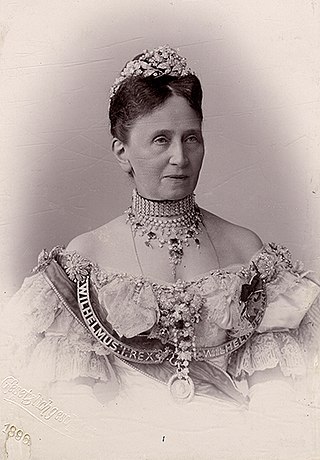
Louise of Prussia was Grand Duchess of Baden from 1856 to 1907 as the wife of Grand Duke Frederick I. Princess Louise was the second child and only daughter of Wilhelm I, German Emperor, and Augusta of Saxe-Weimar-Eisenach. She was the younger sister of Frederick William ("Fritz"), the future German Emperor Frederick III, and aunt of Emperor Wilhelm II.

Prince Friedrich Wilhelm Karl of Prussia was the son of Frederick William II of Prussia and Frederika Louisa of Hesse-Darmstadt.
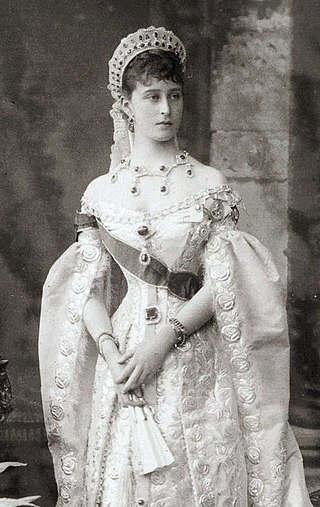
Grand Duchess Elizabeth Feodorovna of Russia was a German Hessian and Rhenish princess of the House of Hesse-Darmstadt, and the wife of Grand Duke Sergei Alexandrovich of Russia, the fifth son of Emperor Alexander II of Russia and Princess Marie of Hesse and by Rhine.

Princess Elisabeth of Hesse and by Rhine was a German Hessian and Rhenish child princess, the only daughter of Ernst Ludwig, Grand Duke of Hesse and by Rhine, and his first wife, Princess Victoria Melita of Saxe-Coburg and Gotha. She was named after her paternal great-grandmother, Princess Elisabeth of Prussia. Her paternal aunt had the same name, and both the young princess and her aunt were nicknamed Ella.

Prince Alexander of Hesse and by Rhine, was the third son and fourth child of Louis II, Grand Duke of Hesse, and Wilhelmine of Baden. He was a brother of Tsarina Maria Alexandrovna, wife of Tsar Alexander II of Russia. The Battenberg-Mountbatten family descends from Alexander and his wife Countess Julia von Hauke, a former lady-in-waiting to his sister.

Charles II was ruler of the state of Mecklenburg-Strelitz from 1794 until his death. Originally ruling as duke, he was raised to the rank of grand duke in 1815. Prior to succeeding to the throne, he served as Governor of Hanover from 1776 to 1786.
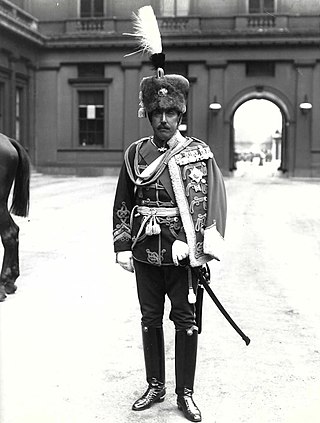
Albert, Duke of Schleswig-Holstein, was a grandson of Queen Victoria. He was the second son of Victoria's daughter Princess Helena by her husband Prince Christian of Schleswig-Holstein. Prince Albert was the head of the House of Oldenburg, and also the House of Schleswig-Holstein-Sonderburg-Augustenburg and the fourth Duke of Schleswig-Holstein between 1921 and 1931.

Princess Irene of Hesse and by Rhine, later Princess Henry of Prussia, was the third child and third daughter of Princess Alice of the United Kingdom and Louis IV, Grand Duke of Hesse and by Rhine. Her maternal grandparents were Queen Victoria and Prince Albert of Saxe-Coburg and Gotha. Her paternal grandparents were Prince Charles of Hesse and by Rhine and Princess Elisabeth of Prussia. She was the wife of Prince Henry of Prussia, a younger brother of Wilhelm II, German Emperor and her first cousin. The SS Prinzessin Irene, a liner of the North German Lloyd was named after her.
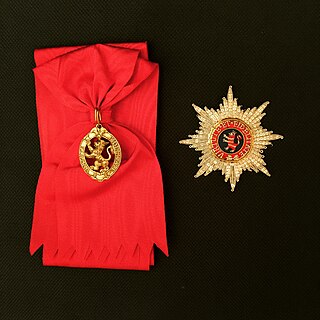
The House Order of the Golden Lion was an order of the German Landgraviate and Electorate of Hesse-Kassel and later, the Grand Duchy of Hesse and by Rhine. It was first instituted in 1770 by Landgrave Frederick II, in honour of and under the patronage of Saint Elizabeth of Hungary, an ancestor of the House of Hesse, and was intended to award auspicious merit.

Eleonore of Solms-Hohensolms-Lich was Grand Duchess of Hesse and by Rhine as the second wife of Grand Duke Ernest Louis. She was nicknamed "Onor" by her family. She was regent of Hesse in the absence of her spouse during World War I.
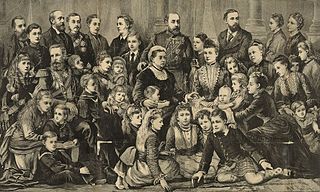
Queen Victoria, the British monarch from 1837 to 1901, and Prince Albert had 9 children, 42 grandchildren, and 87 great-grandchildren. Victoria was called the "grandmother of Europe".

Princess Alice was Grand Duchess of Hesse and by Rhine from 13 June 1877 until her death in 1878 as the wife of Grand Duke Louis IV. She was the third child and second daughter of Queen Victoria of the United Kingdom and Prince Albert of Saxe-Coburg and Gotha. Alice was the first of Queen Victoria's nine children to die, and one of three to predecease their mother, who died in 1901. Her life had been enwrapped in tragedy since her father's death in 1861.
Princess Elisabeth of Hesse and by Rhine (1864–1918), also known as the Grand Duchess Elizabeth Feodorovna, was the daughter of Grand Duke Ludwig IV of Hesse and by Rhine and British Princess Alice, and the wife of Grand Duke Sergei Alexandrovich of Russia.
Alexander, Prince of Erbach-Schönberg was the 2nd Prince of Erbach-Schönberg, eldest son of Gustav, 1st Prince of Erbach-Schönberg.

William of Hesse-Philippsthal-Barchfeld, was a German prince of the Hesse-Philippsthal-Barchfeld branch of the House of Hesse, and Konteradmiral of the Prussian and Imperial German Navy.
Margaret, Princess of Hesse and by Rhine was the wife of Louis, Prince of Hesse and by Rhine, the last prince of the House of Hesse-Darmstadt. Born in Ireland, she became a noted art patron in her adopted homeland of Germany.
References
- ↑ "EX-RULER OF HESSE DEAD IN GERMANY; Grand Duke Ernst Ludwig Was Ousted in 1918 After Reign Praised for Its Wisdom". The New York Times . 10 October 1937. p. 29. Retrieved 8 December 2008.Paid subscription required to read the full article.
- ↑ Packard, p. 161
- ↑ Ridley, Jane (3 December 2013). The Heir Apparent: A Life of Edward VII, the Playboy Prince. Random House Publishing Group. ISBN 978-0-8129-9475-9.
- ↑ Sell, K. (2003). Alice, Grand Duchess Of Hesse. Рипол Классик. ISBN 978-5-87444-192-0.
- ↑ Packard, p. 166
- ↑ Noel, p. 239
- ↑ "Death of the Grand Duchess of Hesse". The Times . 16 December 1878.
- ↑ Packard, p. 167
- ↑ "Carl Backofen (1853-1909) - Group photograph taken during the wedding celebrations of Ernest Louis, Grand Duke of Hesse and Princess Victoria Melita of Saxe-Coburg and Gotha". www.rct.uk. Retrieved 28 December 2022.
- 1 2 Van der Kiste, John. Princess Victoria Melita, Grand Duchess Cyril of Russia, 1876–1936, p. 64, Sutton Publishing, 1991, ISBN 978-0-86299-815-8
- ↑ Sullivan, p. 148
- 1 2 Sullivan, p. 152
- ↑ Sullivan, pp. 217–218
- ↑ See Princess Victoria Melita of Saxe-Coburg and Gotha
- ↑ Röhl, John C. G. R "Wilhelm II: Into the Abyss of War and Exile, 1900–1941", Cambridge University Press, p534
- ↑ Cockfield, Jamie H."White Crow: The Life and Times of the Grand Duke Nicholas Mikhailovich", p61
- ↑ Terence Elsberry, Marie of Romania, St. Martin's Press, 1972, p.62
- ↑ Sullivan, p. 182
- ↑ "Hills & Saunders (1852 to date) - Ernest Louis Grand Duke of Hesse (1868-1937) when Prince of Hesse". www.rct.uk. Retrieved 28 December 2022.
- ↑ Mitterrand, Frédéric (1999). Mémoires d'exil (in French). Robert Laffont. pp. 104–105, 333. ISBN 978-2-221-09023-7.
- ↑ Vickers, Hugo (2000). Alice: Princess Andrew of Greece. Hamish Hamilton. pp. 352, 272–273. ISBN 978-0-241-13686-7.
- ↑ Mateos Sainz de Medrano, Ricardo (2004). "Cecilia de Grecia, gran duquesa heredera de Hesse y del Rhin". La Familia de la Reina Sofía: La Dinastía griega, la Casa de Hannover y los reales primos de Europa (in Spanish). La Esfera de los Libros. pp. 284, 299–302. ISBN 978-84-9734-195-0.
- ↑ Beéche, Arturo E.; Miller, Ilana D. (2020). The Grand Ducal House of Hesse. Eurohistory. ISBN 978-1944207083.
- ↑ Petropoulos, Jonathan (2006). Royals and the Reich: The Princes von Hessen in Nazi Germany. Oxford University Press. p. 524. ISBN 978-0-19-533927-7.
- ↑ Funke, Ulf-Norbert "Leben und Wirken von Karl August Lingner: Lingners Weg vom Handlungsgehilfen zum Grossindustriellen", Diplomica Verlag GmbH, 2014
- ↑ Stopes, Charlotte C. (10 May 1914). "ART AT HOME AND ABROAD; American Paintings at Reinhardt Galleries – Sale of Modern Pictures in Paris – Important Art Exhibitions Abroad" (PDF). The New York Times . pp. SM11. Retrieved 8 December 2008. See section titled Two Important Art Exhibitions in Darmstadt (Hesse) Under the Patronage of the Grand Duke of Hesse-Darmstadt
- ↑ Christopher Warwick, author of the biography of Grand Duchess Elisabeth Feodorovna, entitled 'Ella Princess, Saint & Martyr' published in hardback the United Kingdom by John Wiley & Sons.
- ↑ "TWO MORE RULERS GIVE UP THRONE; Republics Proclaimed in Wurttemburg and Hesse—Ducal Lands Seized" (PDF). The New York Times . 14 November 1918. p. 1. Retrieved 8 December 2008.Hesse mentioned toward the middle of the article
- ↑ Grand Duchy of Hesse [ permanent dead link ] website, discussing burials of the grand ducal family (Retrieved 8 December 2008).
- ↑ Marie, Queen (1934). The story of my life [by] Marie, queen of Romania. State Library of Pennsylvania. C. Scribner’s sons. p. 366.
- ↑ Hof- und Staats-Handbuch des Großherzogtum Hessen (1912/13), Genealogy pp. 1–2
- ↑ "Orden Stern von Brabant – Ehrenkreuz 1. Klasse mit Krone". www.ehrenzeichen-orden.de (in German). Retrieved 22 June 2020.
- ↑ Hof- und Staats-Handbuch des Großherzogtum Baden (1896), "Großherzogliche Orden" pp. 63, 77
- ↑ Hof- und Staats-Handbuch des Königreichs Bayern (1908), "Königliche-Orden" p. 8
- ↑ Sachsen (1901). "Königlich Orden". Staatshandbuch für den Königreich Sachsen: 1901. Dresden: Heinrich. p. 4 – via hathitrust.org.
- ↑ Hof- und Staats-Handbuch des Königreich Württemberg (1907), "Königliche Orden" p. 29